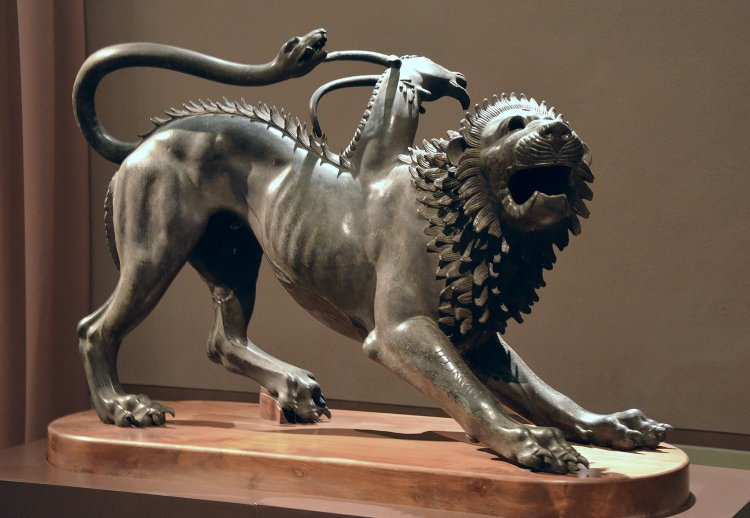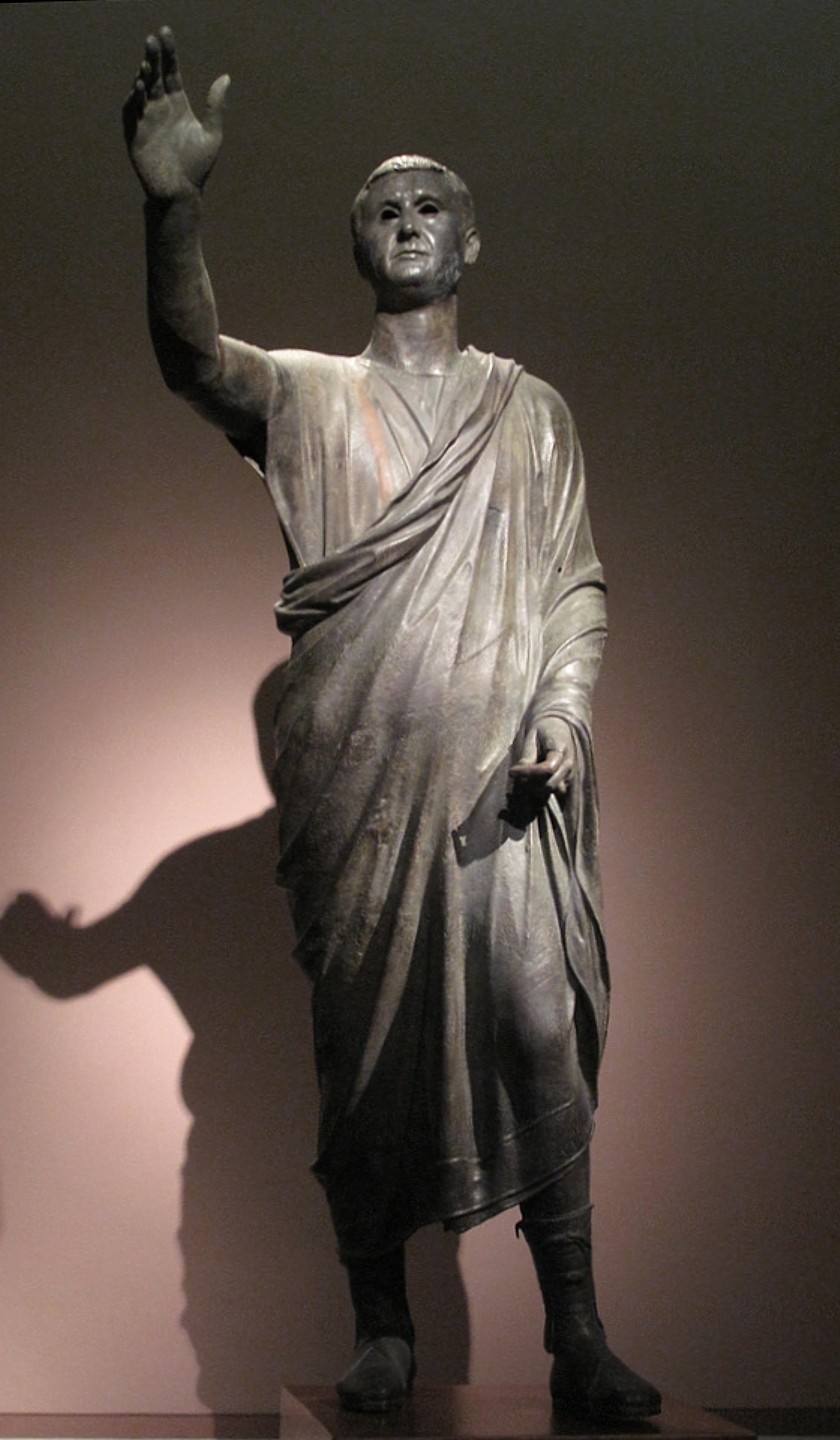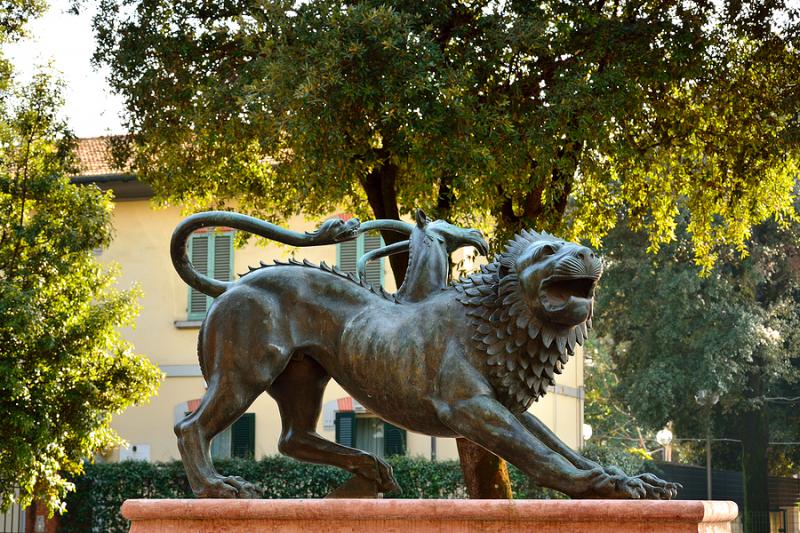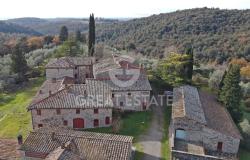Chimera of Arezzo
c. 400 B.C.E., bronze, 129 cm (just over 4 feet) in length
Museo Archeologico Nazionale, Firenze
© Soprintendenza per i Beni Archeologici della Toscana
In 1553, laborers were constructing fortifications near the Porta San Lorentino of Arezzo when they came upon an amazing discovery.
In a trench along the old city wall, they found a scattering of small, ancient metal objects along with one of the most spectacular finds of ancient Italy: a bronze beast the size of a goat, snarling at them from the dirt.
Today, this so called Chimera of Arezzo is widely studied and considered one of the most important works of ancient Etruscan art. But what about when it was discovered? It’s fascinating to imagine what a 16th-century audience might have made of this ancient mythical beast pulled from the earth.

What did people think of this creature in the 16th century?
During the early Italian Renaissance, interest in the ancient Etruscans emerged along with a general fascination with ancient culture. A Dominican monk named Giovanni Nanni began digging up Etruscan sarcophagi around his hometown of Viterbo in the 1490s. He wrote a book published in 1498, in which he attempted to place the Etruscan civilization within a complicated story related to biblical events. He also suggested that the Etruscan language was related to Aramaic. It is interesting to see how these early antiquarians were trying to place the Etruscans within an established Christian chronology.
In 1546, papal authorities collected some 6,000 pounds of ancient bronzes from Tarquinia and melted them down to make the pillars in the church of St. John Lateran in Rome. It seems that even with this revived interest in antiquity, Italian Renaissance authorities valued Etruscan bronzes primarily for their scrap value.
Cosimo and the chimera
A few individuals, however, recognized the artistic value of ancient bronzes. One of these was Cosimo I de Medici, who developed a collector’s taste for Etruscan art at a time when these Etruscan ancestors were barely understood. Under his reign, a number of Etruscan tombs were discovered as Cosimo annexed former Etruscan cities under his rule, including Siena and Chiusi. Cosimo attempted to assert some historical continuity between the ruling clans of ancient Etruria in his own reign of the Tuscan Grand Dukes.

As soon as the snarling ancient chimera was pulled from the ground in Arezzo in 1553, Cosimo ordered the beast to be brought to Florence for examination. Giorgio Vasari, the famous artist, writer, and historian who himself hailed from Arezzo, studied the statue and declared it a bona fide antiquity. Cosimo then hired the goldsmith Benvenuto Cellini to clean it, and then the duke took it into his personal collection at the Palazzo Vecchio. In fact, Cosimo was so enamored with it that he adopted the beast as a symbol of his reign.
Just a few years later in 1566, the fantastic, life-sized orator, the so-called Arringatore, was also pulled from the ground in Arezzo, and it joined Cosimo I’s growing collection.

By the turn of the 1600s, several other Italian nobles and amateur collectors were attempting to create cabinets of curiosities, which included many small Etruscan objects such as mirrors, vases, small bronzes, and other archaeological finds. By the 18th century, the Chimera of Arezzo was moved to the Uffizi and then in 1870, to Florence’s new archaeological museum, where it is still on display. Today, the Chimera of Arezzo is one of the best known pieces of surviving bronze sculpture of the Etruscan period.
Why the hybrid beast?
A chimera is a legendary, fire-breathing creature of Greek mythology that came from Lycia in Asia Minor. This monster was said to have wreaked all kinds of havoc until Bellerophon, a hero from Corinth, mounted the winged horse Pegasus and slayed the chimera.
The chimera is always portrayed as a hybrid creature with features of several animals. In this Etruscan bronze version, the chimera has the head and body of a lion, the tail of a snake, and a goat growing from the middle of its back. The artist responsible for the Chimera of Arezzo has created a sophisticated, complex composition designed to be viewed in the round. Circling this roaring, fire-breathing beast, we appreciate its writhing body, its musculature, its sharp claws, its power, and dynamism.
The chimera seems to be frozen in the midst of battle. The goat head has flopped over, mortally wounded, as thick droplets of blood gush from both sides of the neck. The lean and sinewy lion’s body has also been attacked: blood spurts from a spear wound to the rump. All the same, mane bristling, the creature roars in defiance.
The right foreleg of the animal has an Etruscan inscription on it that suggests this object was a votive offering to the Etruscan sky god, Tinia. We are left to wonder if an aristocratic family might have commissioned this work, one with enough wealth not only to afford this commission but also to donate it in a religious ritual that ended at the bottom of a pit.
The Chimera of Arezzo is a masterwork of Etruscan bronze, giving us a glimpse of the high level of technical proficiency that must have been a hallmark of so many other now-lost works of art. This fascinating beast also demonstrates that the Etruscans were well aware of the themes of Greek mythology that circulated around the Italian peninsula at that time.
Laura Morelli is an art historian and historical novelist with a passion for Italy. You can find much more about what to bring home from Italy in her guidebook series, including Made in Florence and Made in Italy. These books, along with Laura’s Venice-inspired historical novels, including The Gondola Maker, are available in the Italy Magazine shop. Her new novel, The Night Portrait—a dual-timeline story based on Leonardo’s Lady with the Ermine—is out now.









